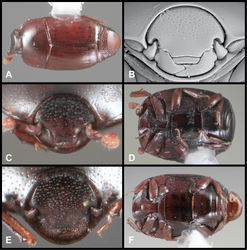Baconia mustax
| Notice: | This page is derived from the original publication listed below, whose author(s) should always be credited. Further contributors may edit and improve the content of this page and, consequently, need to be credited as well (see page history). Any assessment of factual correctness requires a careful review of the original article as well as of subsequent contributions.
If you are uncertain whether your planned contribution is correct or not, we suggest that you use the associated discussion page instead of editing the page directly. This page should be cited as follows (rationale):
Citation formats to copy and paste
BibTeX: @article{Caterino2013ZooKeys343, RIS/ Endnote: TY - JOUR Wikipedia/ Citizendium: <ref name="Caterino2013ZooKeys343">{{Citation See also the citation download page at the journal. |
Ordo: Coleoptera
Familia: Histeridae
Genus: Baconia
Name
Baconia mustax Caterino & Tishechkin, 2013 sp. n. – Wikispecies link – ZooBank link – Pensoft Profile
Type locality
PERU: Madre de Dios:Rio Los Amigos, CICRA [12.57°S, 70.10°W].
Type material
Holotype male: “PERU Madre de Dios, Rio Los Amigos, CICRA 18/21.XI.2006, 25/150m leg. Angélico Asenjo Flight intercept trap” / “Collección MUSM Lima-Peru” / “Caterino/Tishechkin Exosternini Voucher EXO-00509” (MUSM). Paratype (1): PERU: Loreto: 68 km SW Iquitos to Nauta, Rio Itaya, 4°11'S, 73°26'W, 110 m, 18-19.i.2008, A. Petrov (AKTC).
Diagnostic description
Length: 1.3–1.4mm, width: 1.0–1.1mm; body elongate oval, subparallel-sided, humeri slightly wider, subdepressed, glabrous; color rufopiceous, faintly bronzy; head with frons slightly produced over antennal bases, weakly depressed at middle, ground punctation conspicuous, with sparse coarser punctures dorsad, frontal stria present only at upper corner of eye, absent across front, supraorbital stria variably present, frequently fragmented, may be detached from frontal stria; antennal scape short, club more or less circular; epistoma with fine, dense, rugose microsculpture, apical margin faintly emarginate; labrum short, about 4×wider than long, apical margin shallowly emarginate; mandibles short, each with acute basal tooth; pronotum with sides subparallel in basal two-thirds, rather abruptly convergent to apex, lateral marginal stria descending to ventral edge of pronotum in posterior two-thirds, detached from anterior marginal stria, which diverges from anterior behind eye, lateral submarginal stria present in basal two-thirds, diverging slightly from margin toward front, pronotal disk weakly depressed in anterolateral corners, ground punctation fine, very sparse, coarser secondary punctures sparsely scattered in lateral thirds, becoming slightly larger toward prescutellar region; elytra with two epipleural striae, outer subhumeral stria absent, inner subhumeral stria present at extreme base, dorsal striae 1–2 similar in length, only slightly abbreviated apically, 3rd stria present in about basal half, 4th stria slightly longer than 3rd, weakly arched toward scutellum at base, 5th stria shorter than 4th, more strongly abbreviated apically and basally, sutural stria about equal in length to 5th, situated slightly posterad, elytral disk with small, sparse secondary punctures in nearly apical half, extending further anterad toward middle; prosternal keel emarginate at base, with more or less complete carinal striae weakly divergent basally and apically, with few punctures in anterior half; prosternal lobe about two-thirds keel length, apical margin rounded, marginal stria present only at middle; mesoventrite produced at middle, with marginal stria complete, mesoventral disk with a few punctures; mesometaventral stria weakly arched forward, continuous laterally with inner lateral metaventral stria, which extends posterad toward inner third of metacoxa, outer lateral metaventral stria very short, oblique; metaventral disk moderately coarsely punctate at sides, impunctate at middle except for several distinct punctures anteromediad metacoxa; abdominal ventrite 1 with single, complete inner lateral stria, with small secondary punctures in anterior half of middle portion, ventrites 2–5 with fine punctures at sides, those of ventrites 3–4 dense across middle; protibiae with basal and median marginal teeth weak or absent, margin serrulate; mesotibia with two marginal spines; outer metatibial margin with very small subbasal denticle; propygidium lacking basal stria, with fine ground punctation and rather dense, ocellate secondary punctures uniformly separated by about half their diameters, propygidial gland openings inconspicuous; pygidium with sparse ground punctation becoming slightly denser apically, with small secondary punctures conspicuous throughout, larger and denser in basal half. Male genitalia (Figs 44A–D, I–J): T8 broadly, shallowly emarginate at base, ventrolateral apodemes with inner apices subparallel, separated by about three-fourths T8 width, projecting beneath to about ventral midpoint, obsolete apically, apical margin shallowly emarginate; S8 with halves narrowly fused, more strongly sclerotized along midline, basal emargination broad, subacute at middle, basal apodemes tapered, blunt, sides slightly narrowed to apex, apices acutely truncate with inner corner slightly produced, with a few apical setae, apical emargination broad, arcuate; T9 with short, narrow basal apodemes, separated dorsally, ventrolateral apodemes bluntly produced beneath, apices of T9 narrowly rounded, with single subapical seta on each side; T10 with weak apical emargination; S9 with long narrow, medially keeled stem, head abruptly widened, sides weakly rounded to apex, apices acute, widely separated, apical emargination broad, sinuate; tegmen with sides subparallel from base to about midpoint, narrowed to apex, apices subacute, tegmen moderately curved in lateral aspect, with eversible subapical denticles ventrally; median lobe about one-fourth tegmen length; basal piece about one-fourth tegmen length.
Remarks
This species is very similar to Baconia slipinskii, exhibiting a few distinct punctures on the metaventrite anteromediad the metacoxae (Fig. 43F). However, it can easily be distinguished by its distinctive epistomal microsculpture (Fig. 43E). In addition Baconia mustax has relatively coarse pronotal and frontal punctation, and a more strongly dorsoventrally curved aedeagus.
Etymology
The name of this species means ‘mustache’, and refers to the distinctive microsculpture of the epistoma.
Original Description
- Caterino, M; Tishechkin, A; 2013: A systematic revision of Baconia Lewis (Coleoptera, Histeridae, Exosternini) ZooKeys, 343: 1-297. doi
Images
|


